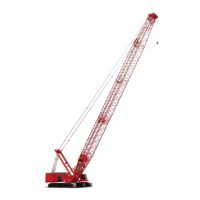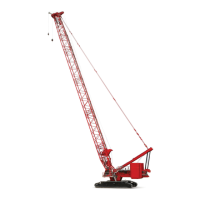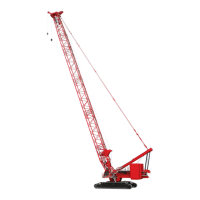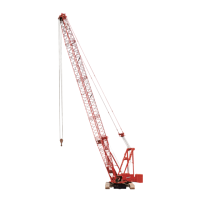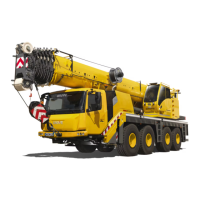Manitowoc Published 10-09-2020, Control # 259-06 8-7
MLC80A-1/MLC90A-1/MLC100A-1/MLC100-1 SERVICE/MAINTENANCE MANUAL UNDERCARRIAGE
CRAWLER PREVENTIVE MAINTENANCE
Weekly or Every 40 Hours of Engine Operation
See Figure 8-4
.
• Lubricate the crawlers as instructed in the Lubrication
Guide supplied with the crane.
• Keep the crawlers clean and avoid dirt buildup when
cutting.
• Keep all mounting bolts tight.
• Keep the treads properly adjusted.
• Inspect the crawler frames, rollers, and treads on a
regular basis.
• Check for oil leaks, excessive wear, cracks, and other
damage. Broken or cracked parts can indicate that the
treads are adjusted too tightly.
• Repair or replace damaged parts immediately to prevent
further damage.
• Inspect the shims (14, View A)(4 places). If the shims
are damaged or difficult to take out or put back in,
replace them with new ones.
• Measure the gap between the shims (14, View A)
(4 places) and the carbody leg (16). If the gap exceeds
dimension (A) install shims (14) so the gap is between
1.0 - 3.0 mm (0.04 - 0.12 in).
CRAWLER TREAD SLACK MEASUREMENT
Weekly or Every 40 Hours of Engine Operation
Check tread slack (B) at the drive tumbler (1, View B) end of
each crawler. Maintain equal tread slack at both crawlers.
1. Travel forward or reverse on a firm level surface until all
tread slack is in the top treads at the drive tumbler end of
the crawlers.
2. Place a straightedge (13, View B) on top of the treads
(3). The straightedge must span from the top of the
rear top roller (17) to the top of the drive tumbler (1).
3. Measure the tread slack between the straightedge and
the top of the tread at the lowest point.
• Tight limit gap—13 mm (.5 in)
• Loose limit gap—51 mm (2.0 in)
4. If the slack exceeds the tight or loose limit, adjust
crawler tread slack.:
CRAWLER TREAD SLACK ADJUSTMENT
See Figure 8-4.
• Tighten the treads when operating on firm ground.
• Loosen the treads when operating on soft ground
(mud or sand).
1. Thoroughly clean the crawler to be adjusted.
2. Remove the covers (9) from both sides of the crawler
frame.
3. Loosen the nut and bolt (8) on both sides of the front
roller (7).
4. Remove the hand pump (5), the cylinder (6), and the
extra shims (10 and 11) from the parts box.
5. Place the cylinder (6) in position to jack against the
adjusting rod (12). Using the hand pump, jack an equal
amount on each side until the track is at the desired
tension.
6. Install an equal number of shims (10 and 11) on both
sides of the crawler frame as needed.
7. Fully retract and remove the cylinder (6).
8. Travel the crane forward or reverse to tighten the shims.
9. Check for proper tread slack.
10. Lubricate the nuts and bolts (8) at the front roller (7) with
Never-Seez or an equivalent anti-seizing lubricant.
11. Tighten the nuts (8) to 2700-4000 Nm (1991-2950 ft-lb).
12. Install the cover (9) on both sides of the crawler frame.
13. Repeat the procedure on the other crawler.
NOTE The extreme limit of tread adjustment occurs when
the bolts are tight against the front end of the slots
in the crawler frame. One crawler tread can be
removed when this limit is reached.
14. Store the hand pump, the cylinder, and any remaining
shims in the parts box.
CAUTION
Avoid Tread Pin Damage!
Do not adjust the treads too tightly or the tread pins will
wear rapidly and may break. Dirt buildup will tighten the
treads further, increasing the possibility of damage.
Tight treads require more drive torque, resulting in faster
wear and increased fuel consumption.
CAUTION
Avoid Parts Wear!
Parts will wear rapidly if an equal thickness of shims is not
installed on both sides of the crawler frame.
CAUTION
Avoid Cylinder Damage!
The tensioning cylinder can be damaged if it is not fully
retracted.

